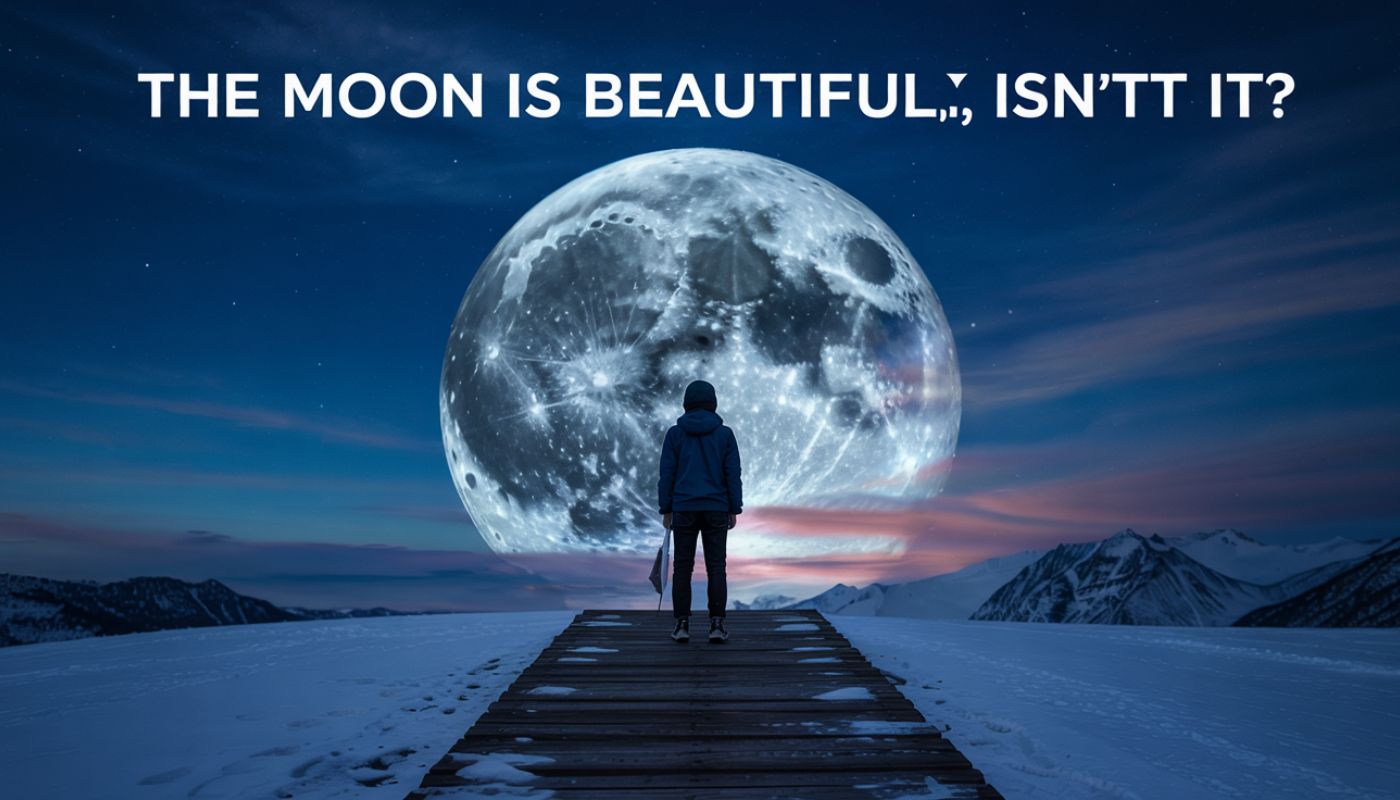The phrase “The moon is beautiful, isn’t it?” (月が綺麗ですね, tsuki ga kirei desu ne) is a remarkable expression in Japanese culture that carries a depth of meaning far beyond its literal translation.
This article explores the origins, significance, and cultural implications of this poetic statement, inviting readers to appreciate its beauty in various contexts.
Understanding the Phrase: “The Moon is Beautiful, Isn’t It?”
At first glance, this phrase may seem like a simple observation about the moon. However, it serves as a subtle form of romantic expression.
In Japan, this phrase is often used to convey feelings of love and affection without directly stating them. It encapsulates the art of subtlety, a cornerstone of Japanese communication.
The Hidden Meaning Behind the Phrase
The beauty of this phrase lies in its layers of meaning. While it literally describes the moon, it metaphorically reflects the speaker’s emotional state. It implies that the beauty of the moon evokes feelings of love, longing, or admiration.
This indirect approach allows the speaker to express vulnerability without the weight of overt declaration.
Origins of the Phrase
The phrase is famously attributed to the renowned Japanese novelist Natsume Sōseki. In his writings, Sōseki suggested that when one wishes to express love, it’s more elegant to refer to the moon than to declare feelings directly.
This literary device has since permeated Japanese culture, becoming a poetic way to convey affection.
Cultural Importance of the Moon in Japan
In Japanese culture, the moon holds significant symbolic value. It is often associated with beauty, tranquility, and transience—qualities that resonate deeply in Japanese aesthetics.
Festivals like Tsukimi, or moon-viewing, celebrate the beauty of the moon, further embedding its importance in cultural practices.
Why the Moon?
The moon’s allure is universal, yet its significance in Japan is particularly profound. It represents the fleeting nature of beauty, echoing the concept of mono no aware—the awareness of the impermanence of things.
This connection amplifies the emotional weight of the phrase, transforming a simple observation into a poignant expression of affection.
The Power of Subtlety in the Japanese Language
Japanese communication often values indirectness and nuance. The phrase “The moon is beautiful, isn’t it?” exemplifies this cultural trait, allowing for a softer, more poetic way to express feelings.
This subtlety encourages deeper connections, as both speaker and listener engage in a shared understanding beyond words.
Natsume Sōseki’s Influence on Modern Language
Sōseki’s influence extends beyond literature into everyday language. His approach to expressing complex emotions through simple observations has inspired countless individuals to adopt this phrase as a means of conveying affection.
It has become a cultural touchstone, illustrating how language can shape interpersonal relationships.
The Phrase in Contemporary Japan
Today, the phrase remains popular, frequently used in romantic contexts. It serves as a gentle reminder of the beauty in everyday moments, encouraging people to pause and appreciate the world around them. In a fast-paced society, this phrase invites a moment of reflection and connection.
Other Japanese Phrases of Endearment
While “The moon is beautiful, isn’t it?” is a standout expression, Japan boasts a wealth of other endearing phrases. For example, “You are like a flower” (hana no you ni) or “You are my sunshine” (anata wa watashi no taiyō) also convey affection in charming, poetic ways.
Comparing Love Phrases in Different Cultures
In many cultures, expressions of love can vary dramatically. For instance, in English, direct phrases like “I love you” are common, whereas in Japanese, subtler expressions prevail.
This comparison highlights cultural differences in how love is communicated, offering rich insights into social norms and values.
How to Use “The Moon is Beautiful, Isn’t It?” in Conversation
Incorporating this phrase into conversation can be a delightful way to express affection. Use it during a romantic evening under the stars or when sharing a quiet moment with a loved one.
It’s a gentle nudge towards deeper emotional connection without the pressure of explicit declarations.
The Phrase in Popular Culture
The phrase has made its way into various aspects of popular culture, from anime to music. It is often referenced in romantic contexts, reinforcing its status as a cultural icon.
This continued relevance highlights the enduring power of Sōseki’s words in contemporary society.
Learning the Art of Indirect Communication
Understanding and using phrases like “The moon is beautiful, isn’t it?” encourages a mastery of indirect communication.
This art fosters deeper connections and greater empathy, allowing individuals to navigate complex emotional landscapes with grace.
The Moon is Beautiful, Isn’t It? Response
A common response to this phrase might be, “Yes, but the stars are even prettier” (hai, demo hoshi no hou ga kirei desu).
This playful banter not only acknowledges the beauty of the moon but also invites further conversation, enhancing the romantic atmosphere.
The Sunset is Beautiful, Isn’t It? Meaning
Similar to the moon, the sunset is often praised in Japanese culture. Saying “The sunset is beautiful, isn’t it?” can evoke feelings of nostalgia and warmth, serving as a reminder of the day’s fleeting beauty.
Conclusion
“The moon is beautiful, isn’t it?” is more than a poetic observation; it’s a rich expression of love and connection embedded in Japanese culture. Its subtlety and depth invite us to appreciate the beauty in both language and life.
As you reflect on this phrase, consider sharing your favorite moments or expressions of affection—what does beauty mean to you?

Mark Johnson is a dedicated writer with 5 years of experience in the celebrity realm, delivering captivating stories and industry insights. Beyond celebrity writing, he has a rich background in general content creation, covering topics from lifestyle to culture. With a knack for storytelling, Mark connects with readers through engaging narratives and fresh perspectives.

